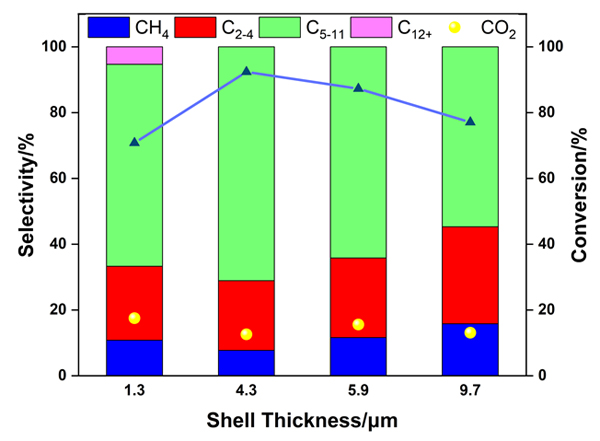摘要/Abstract

在不同的水热合成时间下, 以铁铝合金为铁源和铝源, 四丙基氢氧化铵为分子筛的模板剂和抽提合金中的铝的碱, 一步制得了以骨架铁为核、不同厚度的HZSM-5分子筛为壳的Raney Fe@HZSM-5催化剂. 采用元素分析、氮物理吸附、X射线粉末衍射、氨脱附、扫描电子显微镜等手段, 考察了水热时间对催化剂基本物化性质的影响. 随着水热时间的延长, HZSM-5分子筛壳层不断增厚, 结晶度不断增大, 但分子筛组成基本不变, 酸量与分子筛壳层厚度正相关. 在费托合成反应中, Raney Fe@HZSM-5核壳催化剂上的CO转化率和汽油段产物选择性随分子筛壳层厚度呈火山型变化趋势, 说明反应需要适宜的酸量, 酸量过低或过高均不利于得到高的催化活性及汽油段产物选择性. 在水热合成时间为4 d制得的Raney Fe@HZSM-5核壳催化剂上, 当CO转化率为92%时, C5~C11汽油段产物选择性可达71%, 异正比为1.9. 当合成气中的n(H2)/n(CO)比从2降为1时, 汽油段产物选择性和异正比进一步提高至73%和2.1, 显示了将该催化剂用于煤基或生物质基合成气转化为高辛烷值汽油的良好潜力.
关键词: 骨架Fe, HZSM-5, 核壳结构, 费托合成, 汽油
Using the Raney Fe-Al alloy as the precursor for Fe and Al, and tetrapropylammonium hydroxide (TPAOH) as both the base for the leaching of the alloy and the template for the synthesis of HZSM-5, we synthesized the skeletal Fe core-HZSM-5 shell catalysts (Raney Fe@HZSM-5) via a facile one-pot hydrothermal strategy. The thickness of the zeolite shell was adjusted by varying the hydrothermal time. The catalysts were characterized by inductively coupled plasma-atomic emission spectroscopy (ICP-AES), N2 physisorption, X-ray powder diffraction (XRD), temperature-programmed desorption of NH3 (NH3-TPD), and scanning electron microscopy (SEM). It was identified that the Raney Fe-Al alloy was more suitable than the rapidly quenched Fe-Al alloy as the precursor to the skeletal Fe core, since the skeletal Fe catalyst alkali-leached from the former produced more long-chain hydrocarbons during the Fischer-Tropsch synthesis (FTS) reaction for successive cracking and isomerization. A complete HZSM-5 shell was obtained only after above 24 h of hydrothermal treatment. With the hydrothermal time from 2 d to 8 d, the thickness of the compact HZSM-5 shell increased from 1.3 μm to 9.7 μm, the relative crystallinity increased steadily, while the SiO2/Al2O3 ratio remained essentially constant, and the amount of the acid sites is parallel to the thickness of the zeolite shell. In the FTS reaction using syngas with the H2/CO molar ratio of 2 and at 543 K and 2.0 MPa, the CO conversion and the selectivity to the gasoline fraction (C5~C11 hydrocarbons) evolved in a volcanic trend with the shell thickness, suggesting the existence of an optimal amount of the acid sites, while less or more is adverse to the activity and selectivity to the gasoline fraction. The Raney Fe@HZSM-5 catalyst hydrothermally treated for 4 d exhibited the highest CO conversion of 92% and the selectivity to the gasoline fraction of 71%, along with an iso-paraffin to n-paraffin ratio of 1.9. At the n(H2)/n(CO) ratio of 1, the selectivity to the gasoline fraction and the iso-paraffin to n-paraffin ratio were further improved to 73% and 2.1, respectively, which shows promise for this catalyst to transform the coal- or biomass- derived syngas to high-octane number gasoline.
Key words: skeletal Fe, HZSM-5, core-shell structure, Fischer-Tropsch synthesis, gasoline
PDF全文下载地址:
点我下载PDF
